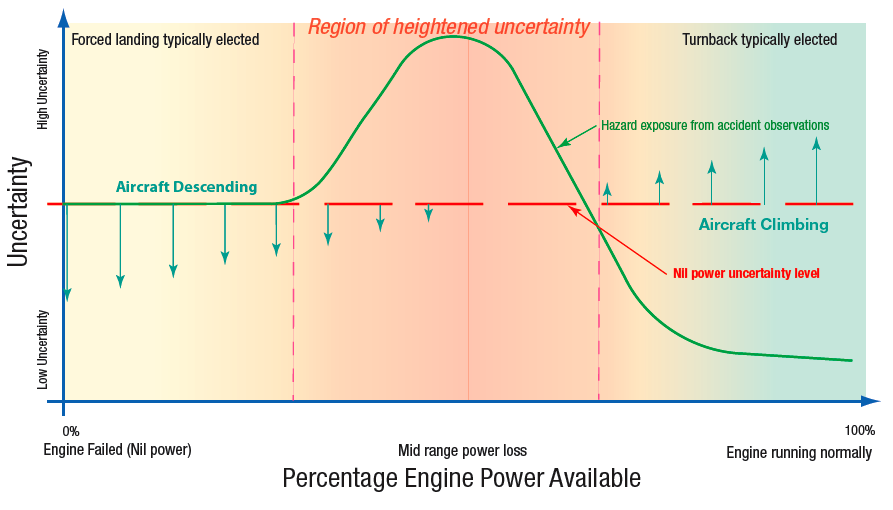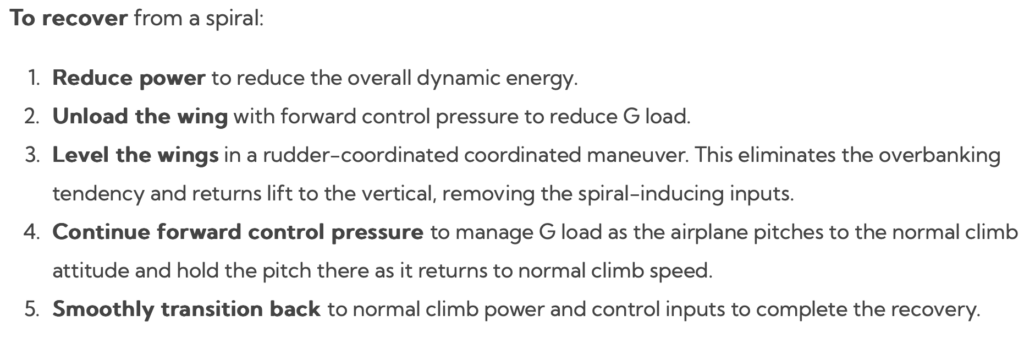Topics this week include: > Partial power loss > The Region of Heightened Uncertainty > Three objectives

Last weekend I was a guest speaker representing my employer at the Beech Bash in the Bluegrass(TM), a grassroots social fly-in with an educational component primarily for Beechcraft(TM) pilots. In that talk the topic of partial power loss came up—because I brought it up—along with audience agreement that we almost never address partial power loss in flight instruction. We do not evaluate the pilot’s ability to recognize and properly react to a partial loss of power during Practical Tests for pilot certificates and ratings. And yet, partial power loss is at least as likely as a total, catastrophic failure.
A decade or so ago during a visit Down Under I was privileged to spend an afternoon in the headquarters of the Australian Transport Safety Bureau (ATSB), and left with a box full of ATSB-generated educational materials. One of the most interesting reports is Avoidable Accidents No. 3: Managing Partial Power Loss after Takeoff in Single-Engine Aircraft. The Introduction to this report tells us ATSB’s data “shows that during takeoff and after takeoff, a partial power loss is three times more likely in today’s light single-engine aircraft than a complete engine failure.”
The ATSB guide continues: “There have been nine fatal accidents from 2000 to 2010 as a result of a response to a partial power loss [immediately after takeoff] compared with no fatal accidents where the engine failed completely.” Roughly one fatal mishap a year may not seem significant (it is to the airplane’s occupants, their families, friends and co-workers). The interesting point is the disparity between partial power loss fatalities and those that (didn’t) result from total engine failures during or shortly after takeoff. Total engine failures happen, according to ATSB, it’s just that they haven’t resulted in deaths like partial engine failures have done.
I won’t repeat the entire ATSB report; downloading and reading the 29-page report is your FLYING LESSONS homework for the week. I will reiterate, however, a portion of the ATSB’s summary:
- Many partial power losses could have been prevented by thorough pre-flight checks. Some conditions reported as causing partial power loss immediately after takeoff are fuel starvation, spark plug fouling, carburetor icing and pre-ignition conditions. In many cases, these conditions may have been identified in preflight or when completing a Before Takeoff checklist.
- Considering actions to take following a partial power loss after takeoff during the process of flight planning and the preflight safety brief gives a pilot a much better chance of maintaining control of the aircraft. Considerations include planning for a rejected takeoff, landing immediately within the aerodrome, landing beyond the aerodrome, and conducting a turnback toward the aerodrome.
- If nothing else, maintain glide speed and stay below a maximum bank angle you will not exceed if a turnback is an option. Be prepared to reassess the situation throughout any maneuver.
This brings us to my Three Objectives for engine failure immediately after takeoff…which are just as valid for a partial power loss as they are for total engine failure.
1. Maintain control of the aircraft;
2. Restart the engine if possible and time permits; and
3. Land wings level, under control, at the slowest safe speed
The challenge becomes: When do I know I’ve had a partial power loss?

ATSB’s research shows that a slight power loss after takeoff (toward the right of the ATSB chart above) may not be enough to prevent a safe return to the aerodrome (airport) for a fairly normal landing. Conversely, a nearly total engine failure(toward the left of the chart) gives the pilot little choice but to descend, and at least in Australia’s study history the pilot usually continued straight ahead…and survived.
The Region of Heightened Uncertainty, however, is where engine power loss is substantial but not yet complete. This creates an “uncertainty” on the part of the pilot: “Do I really have an engine problem?” “How bad is the power loss?” “Can’t I just coax the airplane up to a safe altitude and figure out what’s happening?” “Should I turn back to the airport?”
“The course of action chosen following such a partial power loss…can be strongly influenced by the fact that the engine is still providing some power, but this power may be unreliable. [You may] have a strong desire to return the aircraft to the runway to avoid aircraft damage associated with a forced landing…. The complexity of decision making in such circumstances is further compounded by the general lack of discussion and training on [the topic of partial power loss].”
ATSB suggests several ways to prevent a partial engine power loss (read the report), and a familiar-sounding technique for managing a partial engine power loss if it occurs (simplified somewhat here):
- Lower the nose to maintain glide speed (assuming the power loss occurs during initial climb).
- Troubleshoot the engine and attempt a restart only if there is sufficient time.
- Maintain glide speed and assess whether the aircraft is maintaining, gaining or losing altitude to gauge current aircraft performance and determine options available for landing.
- Fly the airplane to make a landing given the aircraft’s height and performance.
- Make no turns below 200 feet AGL.
- Land the aircraft under control.
This sounds very much like my Three Objectives for engine failure described above and detailed in past FLYING LESSONS.
Surviving a partial power loss rides on identifying that the engine has lost some power in the first place. Only then can you employ techniques for managing the loss. So how can you detect a partial power failure on takeoff?
Try this exercise: With an instructor or trusted pilot as a safety observer, and to record information for post-flight review:
- Make a series of normal and short-field takeoffs.
- On each of those takeoffs, use care to fly the desired airspeed—Vx for short field, Vy for a “normal” takeoff and, if you routinely do so for engine cooling or a cushion of airspeed for control when no obstacles block your departure path, a Vclimb speed of your choosing.
- For each takeoff, record the pitch attitude that results in the target speed. Record both the Attitude Indicator indication, if your airplane is so equipped, and your subjective description of the attitude as seen out the front of the airplane (“top of the cowling on the horizon”, etc.).
- Record the approximate rate of climb for each attitude/airspeed combination.
- Now climb to 5000 – 6000 feet above sea level (unless your home airport is already at or above that height). Adjust the mixture in piston-powered airplanes so that it is at the maximum horsepower position at full throttle…which is approximately how fuel flow will be set for a real-world high density altitude takeoff.
- Repeat the departure exercise by simulating a takeoff run in the takeoff configuration (flaps and landing gear per your airplane and your routine), establishing the target airspeed and raising the nose to the Vx, Vy and Vclimb attitudes on successive “takeoffs.”
- Record the proper attitudes (indicated and subjectively visual) for high density altitude departures.
- Record the approximate rate of climb for each attitude/airspeed combination.
How is this information useful? If you are precise with hitting an attitude and airspeed target for the type of takeoff (short field, normal and “personalized”), you will have a predictable rate of climb each for near-sea-level and relatively-high-density-altitude conditions. The only variables will be airplane weight and turbulence. If you hit your pitch target and the speed and rate of climb are less than you expect from completing this exercise, then suspect you have a partial power loss. Scan the instruments briefly (partial power loss may be reflected in EGT, CHT or fuel flow indications) to see if you have immediate confirmation of a power loss. But do not dismiss the possibility of partial power loss even if your initial scan shows no obvious problem.
At that point, follow the ATSB technique of establishing Best Glide speed to see if the airplane is capable of climbing, can only climb slightly or hold altitude, or is losing altitude. This will tell you is you need to aim for the Three Objectives and get the airplane back on the ground.Below is a suggested annual training regimen for preparing for engine failures including partial power loss on takeoff. These are minimum suggestions, and you don’t have to take the entire training at one time—in fact it’s better to spread it out over the year so you’re never too distant from a good training experience. Note that the added performance of a second engine comes at a cost (beyond fuel, and insurance, and upkeep…). Multiengine pilots should budget additional time and funds for engine-out training, and in my opinion are not truly prepared to take advantage of the option of continued flight on one engine until they have some experience and regular practice with engine failures during and immediately after takeoff. The only way to get this experience realistically and safely is in a Flight Training Device or simulator.

Questions? Comments? Supportable opinions? Let us know at [email protected].
Debrief
Readers write about previous LESSONS
Reader Howard Page, founder of an early list-type online discussion group for Beech pilots (appropriate named “The Beech List”), writes about last week’s LESSONS about spiral instability and spiral recovery:
As I’m sure you are aware, V-tails are unstable in a spiral dive. Several times while under the hood, I’ve asked the instructor/safety pilot to place the aircraft in a spiral dive with my eyes closed. Recovery is intense! Moving the wings level, the airplane shot up! I recommend every V-tail Bonanza owner practice it.
It’s not just V-tail Bonanzas, Howard, it’s any pitch-stable airplane to one degree or another. Last week’s report was instigated by the report of a Cessna 210 crash, for example. I demonstrate spiral tendencies and recovery on all models of airplane in which I teach and agree it’s a good thing to carefully practice in any airplane. That’s why I built a Mastery of FlightÒ LESSON around it. Thank you, Howard.
Reader and 45-year airplane owner Stan Stewart adds:
Good discussion on recovering from spirals. As a point of discussion, you list five steps to take in recovering from a spiral, but not until the third step take action to stop the turn. I think stopping the turn is the most important concept pilots need to knowregarding recovering from a spiral. I was taught the most important thing to do first is to stop the turn with the rudder and aileron but the rudder is the most important flight control to use to stop the turn in a spiral. This can be done while simultaneously reducing the power, but stopping the turn is the most important thing to do first, as the spiral cannot be recovered from when the airplane is turning. Then gently use forward pressure the elevator to allow the nose to come up to level flight without over stressing the airplane. This may not be the most efficient technique to recover from a spiral, but stopping the turn is critical to recover from a spiral. I would invite further discussion about the best way to recover from a spiral.
Since unlike a spin where yaw at a high angle of attack means stopping the turn is done primarily with rudder, in a spiral the airplane is likely in or very close to coordinated flight. Stopping the turn results from a coordinated use of aileron and rudder together. In a demonstration or practice maneuver we enter the spiral from a slow speed and, at least the way I recommend, recover before reaching VA or 60° bank turn, whichever is reached first. If the spiral begins at a faster speed and/or is allowed to exceed one or both of those limits the nose-up movement to regain the original trimmed indicated airspeed may impart a strong G-load immediately as the lift vector returns to vertical (relative to the horizon).

Your point is consistent with something I almost included in last week’s LESSONS: that unloading and leveling the wing are essentially simultaneous actions. Such is the limitation of describing a four-dimensional (including time) control input in a two-dimensional checklist. Either way, it’s vital to stop the spiral in a way that does not overload the airframe. Thanks, Stan.
Reader and rapidly becoming legendary flight instructor Doug Rozendaal wraps it up this week:
If the [Cessna 210 that was inspiration for the spiral discussion] had steam gauges, and the vacuum pump failed, it could easily explain this accident. Recognizing and recovering from a failed vacuum pump in turbulence close to the ground would be a very tall order.
I believe all unusual attitude recoveries should be done partial panel. The most likely scenario that causes an actual unusual attitude event is a primary ADI [attitude deviation indicator] or an autopilot failure. Your story reminded me of an article I wrote many years ago for IFR magazine. Since your site is educational, I do not think there are any copyright issues if you want to use it in part or in full.
I suspect you’re right. I included instrument failure—real or instructor-induced—among the possible scenarios in the C210 event that prompted this discussion before launching into the larger topic of spiral entry (for whatever reason) and recovery. Thank you, Doug.
Since IFR was recently discontinued and I do not see back issues online I have posted Doug’s draft of the article for readers to continue to learn from it. Thank you again.
More to say? Let us learn from you, at [email protected]

Share safer skies. Forward FLYING LESSONS to a friend.
Please help cover the ongoing costs of providing FLYING LESSONS through this secure PayPal donations link. Or send a check made out to Mastery Flight Training, Inc. at 247 Tiffany Street, Rose Hill, Kansas USA 67133. Thank you, generous supporters.
“[My donation is] long overdue support for you and your incredible work. Thanks as always for providing the best continuing General Aviation education in the industry.”
– Andrew Urban, Sun River, Wisconsin
Thank you, Andy, for your continued contributions toward the costs of hosting and delivering Mastery of Flight.(TM) And thank you to all these FLYING LESSONS readers:
Thank you to our regular monthly financial contributors:
Steven Bernstein, Montclair, NJ. Robert Carhart, Jr., Odentown, MD. Greg Cohen, Gaithersburg, MD. John Collins, Martinsburg, WV. Dan Drew. Rob Finfrock, Rio Rancho, NM. Norman Gallagher. Bill Griffith, Indianapolis, IN. Steven Hefner, Corinth, MS; Ellen Herr, Ft Myers, FL. Erik Hoel, Redlands, CA. Ron Horton. David Karalunas, Anchorage, AK. Steve Kelly, Appleton, WI. Karl Kleiderer. Greg Long, Johnston, IA. Rick Lugash, Los Angeles, CA. Richard McCraw, Hinesburg, VT. David Ovad, Resiertown, MD. Steven Oxholm, Portsmouth, NH. Brian Schiff, Keller, TX. Paul Sergeant, Allen, TX. Paul Uhlig, Wichita, KS. Richard Whitney, Warrenton, VA. Jim Preston, Alexandria, VA. Johannes Ascherl, Munich, Germany. Bruce Dickerson, Asheville, NC. Edmund Braly, Norman, OK. Steven Hefner. Lorne Sheren, New Vernon, NJ. “The Proficient Pilot,” Keller, TX. Ed Stack, Prospect Heights, IL. Kynan Sturgiss, Hereford, TX. Bluegrass Rental Properties, LLC, London, KY. John Foster. Joseph Victor, Bellevue, WA. Chris Palmer, Irvine, CA. Barry Warner, Yakima, WA. Todd LeClair, Cadiz, KY
NEW THIS WEEK: Robert Hoffman, Florence, KY
Thanks also to these donors in 2025:
John Teipen. N. Wendell Todd. David Peterson. Jay Apt. SABRIS Aviation/Dave Dewhirst. Gilbert Buettner. David Larsen, Peter Baron, Glen Yeldezian, Charles Waldrop, Ian O’Connell, Mark Sletten, Lucius Fleuchaus. Thomas Jaszewski. Lauren McGavran. Bruce Jacobsen, Leroy Atkins, Coyle Schwab, Michael Morrow, Lew Gage, Panatech Computer (Henry Fiorentini), John Whitehead, Andy Urban, Wayne Colburn, Stu Spindel, Dave Buetow, Ken Vernmar, Dave Wacker, Bill Farrell, David Miller
Pursue Mastery of Flight(TM)
Thomas P. Turner, M.S. Aviation Safety
Flight Instructor Hall of Fame Inductee
2021 Jack Eggspuehler Service Award winner
2010 National FAA Safety Team Representative of the Year
2008 FAA Central Region CFI of the YearFLYING LESSONS is ©2025 Mastery Flight Training, Inc. For more information see www.thomaspturner.com. For reprint permission or other questions contact [email protected]


